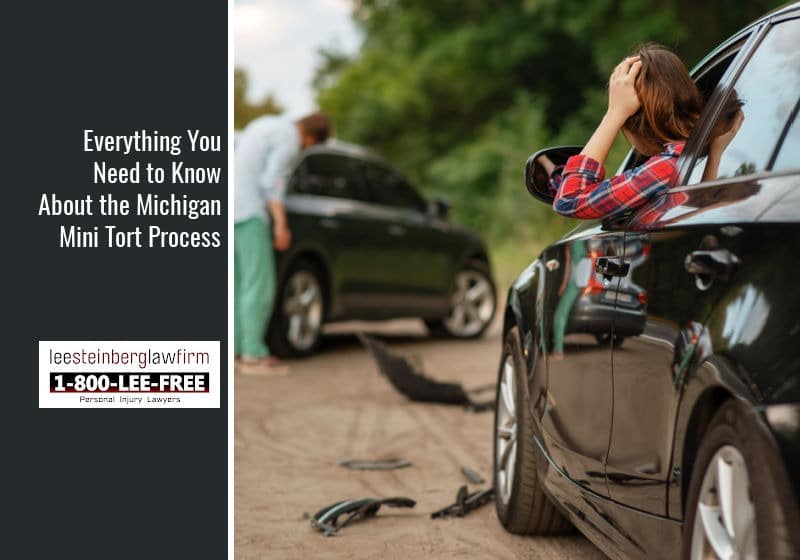
Car accidents are a common sight on Michigan’s bustling roads. In fact, there were around 320,000 wrecks in 2021 alone. If you suffer from an accident that isn’t your fault, you need to recover as much money as possible to repair your vehicle, especially if you lack sufficient collision coverage or have a deductible. Unlike other states, Michigan has a mini tort law that enables people to recover money from at-fault drivers for vehicle damage. In this law blog, you’ll learn all about the Michigan mini tort process.
What is the Mini Tort Law in Michigan?
Before diving into the Michigan mini-tort process, it’s important to understand specifics regarding the law and how it has changed in the last few years.
The Michigan mini tort law allows individuals who are less than 50% responsible for a car accident to file a claim or civil suit against the at-fault driver for vehicle damage. The maximum amount that people could recover from liable drivers used to only be $1,000, but the Michigan mini-tort law now allows car accident victims to recover up to $3,000 for vehicle damages.
$3,000 may sound like a small amount of money after a Michigan car accident, but it’s important to recognize that the mini-tort law isn’t designed to cover all of your expenses. Instead, it is merely intended to cover your collision insurance deductible or damages that your insurance doesn’t cover. If you have broad collision coverage, you won’t be able to recover vehicle damages from the at-fault driver. Instead, your own insurance will be responsible for covering your vehicle damages.
When filing a mini-tort claim, it will either be the at-fault driver’s or their insurance company’s responsibility to pay. The liable driver’s insurance will cover your vehicle damages – again, only up to $3,000 – if they have limited property damage liability insurance. If the driver doesn’t have this insurance coverage, they will be responsible for your vehicle damages up to $3,000.
In order to recover money from the liable driver, you need to have auto insurance. Even if the other driver was fully responsible, you won’t be able to recover damages via mini-tort without having car insurance. This rule applies if the other driver was reckless or drove while under the influence of alcohol.
How to File a Mini Tort Claim in Michigan
In order to get compensation from the at-fault driver or their insurance company, you’ll need to supply certain information and documentation. You have three years from the time of your accident to file a claim or lawsuit, but you should consider filing once you have all of the necessary evidence and documentation.
First, you’ll need to obtain information about the person who caused the accident. This includes their name, address, and auto insurance information. If the at-fault driver isn’t the owner of the vehicle, you’ll need to obtain the name and address of the vehicle’s owner. Additionally, the driver must show you their driver’s license.
If the driver is insured, you’ll also need to obtain their insurance information, including:
- The name of their insurance company
- The name of the insurance company covering the car if they aren’t the owner
- Their policy number
- The name and phone number of their insurance agent
Next, you’ll need to obtain a copy of the police’s accident report, also called a UD-10 or Traffic Crash Report. The police report will verify the at-fault driver’s information and will also be valuable in proving that the at-fault driver was responsible for your wreck.
Additionally, you should gather all evidence possible that proves that the other driver was liable. This can include photographic and video evidence as well as eyewitness testimonies. If any witnesses saw the event unfold, make sure to write down their accounts as well as their names and contact information.
You’ll also need to obtain a copy of your own car insurance policy’s Declarations Page, which proves that you have an auto insurance policy. This document will also show whether you have collision insurance and if your insurance has a deductible. Again, if you have collision insurance that doesn’t have a deductible, your own insurance company will pay all the damages.
In addition to gathering this necessary documentation and evidence, you’ll need to determine how much it will cost to fix your car. You should obtain an estimate from a repair shop or dealership. In the alternative, take photos of the your vehicle damage. You need to substantiate the property damage so the other person’s car insurance will pay the mini-tort claim.
Finally, you’ll need to inform the liable driver’s auto insurance company about your claim in order to recover payment. They will request a copy of the police report, damage photos, repair estimates and your own auto insurance declaration page before sending you a check. If the at-fault driver is uninsured, you’ll need to file a mini-tort lawsuit against them in small claims court.
Does the Mini Tort Law Cover Personal Injuries?
The Michigan Mini Tort law only covers up to $3,000 of vehicle damage and does NOT cover any expenses related to personal injuries, such as doctor’s visits, surgeries, and medications.
If you were injured in your wreck, you’ll need to contact a Michigan car accident attorney who can help you get compensation for your injuries from the liable driver. Depending on your case, you may be able to recover damages for medical bills, pain and suffering, lost wages, loss of future income, and more.
For expert legal support, you can count on after a wreck, contact the attorneys at Lee Steinberg Law Firm. You can schedule a no-risk, free case evaluation today by calling 1-800-LEE-FREE (1-800-533-3733), or you can schedule your evaluation online here.

